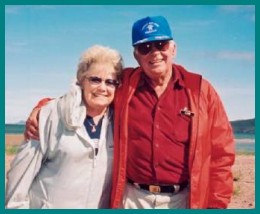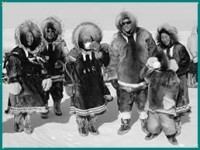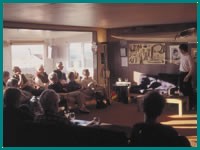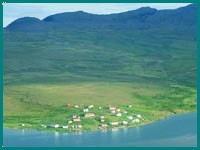|
|
ECOCLUB® |
|
||||
|
ISSN 1108-8931 |
International Ecotourism Monthly |
Year 4, Issue 46, Mar. 2003 |
||||
|
The ECOCLUB
Interview Glenn &
Trish Warner
|
||||||
|
On a practical note, there were a number of buildings available that could easily be converted into lodging. With the assistance of two partners, Fred H. Ross and Lyle Hawkins of Cambridge Bay, we purchased not only the buildings of the HBC post, but also the land. Being able to buy land in the arctic was extremely unusual. To make a long story short, after an enormous amount of work, Bathurst Inlet Lodge opened in July of 1969 and has operated every summer since. We have always employed as many of the local people as cared to work, and have seen three generations grow up in the area, working with the Lodge. In the early years, while I was still serving with the RCMP, Trish ran the lodge on her own with the local people. Our three children literally grew up in the community and working at the lodge. All three have remained in the North and are involved in tourism -- daughter Kim operates Top of the World 2000 travel agency. Daughter Teri is a co-owner in a large and successful bush airline, and son Boyd manages the Bathurst group of companies, from the lodge to camps to a charter airline to sport hunting camps. Their characters were shaped by their experiences at Bathurst Inlet and their friendships with our Inuit friends and partners. In the 1980s, some programs became available to help aboriginal people in northern Canada get involved in business. Trish and an upper level bureaucrat in the NWT government worked out a plan by which we helped the Inuit of Bathurst Inlet to purchase half of Bathurst Inlet Lodge, and we have worked closely with our Inuit partners ever since. They have paid off their loan and are fully involved in all aspects of the Lodge, including operation and decision making. In addition, they are also fully involved in sharing their knowledge of the land, the wildlife, and their culture with visitors from around the world.
Bathurst Inlet Lodge offered ecotourism before the word was coined, we just called it a "naturalist's lodge". We practice classical ecotourism in that we teach about the land, the wildlife, the history, and the cultures of the central Arctic, as well as issues that face our land and people. We teach out on the land and on the sea, utilizing fuel efficient means of transportation (a large pontoon boat and hiking). In addition, the ownership structure and employment opportunities engendered by Bathurst Inlet Lodge ensures that the local residents benefit clearly and significantly from the business of ecotourism. The fact that they have become close friends with many of our guests (about 25% of our guests in any given year are repeat visitors, and some have visited more than 10 times) is a bonus for all.
Bathurst Inlet Lodge is similar to a few other Canadian lodge operations, such as Sila Lodge, in that local Inuit are also fully involved as owners and operators, and in that both offer a quality program that fully utilizes traditional knowledge and skills. Bathurst is different from many lodges in other parts of Canada that it is truly like stepping 40 years back in time, to a time when people of all races lived together in mutual dependency in the arctic, and depended fully on their own resiliency and skills to survive. The buildings are historic, and we try hard, without role-playing, to give people a true feeling of what the arctic was like in the past, while still interpreting the swift changes that are so characteristic of today.
Fully and entirely. Only about 16 people live year round in Bathurst Inlet. This population increases to about 25 in the summer when kids are home from school and when people who work full time most of the year move back to help with the Lodge and to enjoy their traditional way of life in the summer. Everyone who wants to work and is of an age to work is offered an opportunity to join the lodge staff in the summer, and we are certain that the work experiences at the Lodge have contributed to the employability and reliability of many of the people who grew up at the Inlet. People radiate a pride of ownership, and participate enthusiastically. For example, we offer a cultural program one night a week, in which Sam Kapolak, our boat captain, interprets the traditional tools and hunting implements, describing traditional methods of seal and caribou hunting, the use of the bow drill, and more. Our local families model traditional caribou skin clothing and one of the young women demonstrates the lighting of the kudlik, or soapstone lamp. Our staff is not required to attend, but everyone does, from the elders right down to the youngest children. Their pride in seeing their culture interpreted for people from all over the world is evident in their faces.
Not really. Consciously or unconsciously, we use the Inuit way, which is based on consultation and consensus, and keep everything as casual and as kind as possible. People are not pressured into decisions or into involvement, but increase their involvement as they grow and feel comfortable. There are no formal agreements.
There is no doubt in our minds but that Bathurst Inlet as a community would have ceased to exist in the 1970s had the lodge not been present as a source of income for the local people. Had the charter flights generated by lodge business not been available to the people as an inexpensive way to get staple foods, building materials, etc. to their community, they would not have been able to afford to live where there are no scheduled flights. People would simply have had to move into the community centres, as has happened throughout the North. And the Kingaunmiut do not want to move to a larger community. Bathurst is their home, many were born there and love it deeply. It is a hauntingly beautiful land rich in wildlife and flora, and the residents of Bathurst Inlet are the envy of their peers throughout the North. We'll share a quote from our Nunavut Cabinet: "Enclosed is a group picture of the Nunavut Cabinet and support staff during our wonderful stay at your lodge. The beautiful surroundings and your hospitality enabled us to produce the "Bathurst Mandate", which has set major directions for all our work across Nunavut for the five year term of this government. We all dream of coming back, and the Ministers say, when they see the photo, 'Now, that week, we were all very happy, you can tell by the faces.'" Anne Crawford, Secretary to the Nunavut Cabinet, Iqaluit, Nunavut. At the same time, exposure to kindly, well-educated people from around the world has been beneficial to the young people of our small community in that they have heard many stories of other parts of the world, and have seen people who obviously enjoy reading and using their minds. These guests challenge our young people, encouraging them to think, to explain their world.
Our Inuit partners participated in one grant/loan program that enabled them to buy into the lodge, and we have participated in cost-sharing marketing programs, that help our advertising dollars go further. However, if I had to state one simple fact that has enabled us to exist through good tourism times and bad, it is this: "DON'T BORROW MONEY! Do what you can with resources you have, treasure all your assets, and work very hard to ensure that they are kept up. Don't overextend yourself so that you are not able to service your debts." Our naturalist, Page Burt, works as a tourism consultant in Nunavut and the NWT, and often has seen interest in tourism development sparked not by a desire to share information or experiences, but by the desire to take advantage of government funding to get "something", be it a boat, ATV, snowmobile, or a camp. Unfortunately, many of these operators may attract a few guests, but since their hearts are not in the delivery of the experience, it falls short.
Our typical guest is middle-aged, well-educated, and has an enquiring mind. Some are interested in specifics, like birds or wildflowers, or history, but most are generalists, interested in EVERYTHING about the Arctic. We virtually never discuss "ecotourism", so have very little idea what people actually think about it as a topic. Our discussions revolve around the land, the wildlife, the history, and the way the Inuit survive in the land. We live our ecotourism, but don't talk about it much.
We are quite straight with our guests about this - stating the facts: that the Inuit have always depended on the animals for sustenance, food, clothing, tools, fuel, and shelter. We make it clear that there is no nearby store where one can drop in and pick up a handy styrofoam tray of chicken, and point out the high cost of food in the arctic. We discuss the nutritional value of the "country foods", and show people the drying fish (pipsi) and caribou (mipku) which are a staple of the local diets. We discuss hunting techniques and use many of those techniques with our guests to get them close to a muskox, caribou, or nesting loon. We invite discussion on both hunting and trapping, and discuss the changing economy of the North based on the artificial market created by the demand for white fox skins, and the crash due to reduced demand. Yes, we also discuss the far-reaching negative effects of legislation like the Marine Mammal Protection Act of 1972 in the US, which has wrecked the market for seal skins across the North. As northerners, we understand the role of fur in our lives, understand that it is a renewable resource for northern peoples, and do not hide it. We believe that over the years, many people have learned that there are two sides to most issues, and have graciously heard ours.
This does not create huge problems. Summer in the arctic is short, and the land blooms for only a short time. We have long since decided that it is best for visitors to see our land in the glory of the Arctic summer, when everything is at its best, and there is little danger from travel on or around moving sea ice. We have long accepted that most of us must do something else to make a living, taking this time in the summer to share our love and knowledge of the North with others. This decidedly includes our Inuit partners, as well. They love the weeks of our summer season when the guests are at the Lodge, but they also love taking off with their families to renew their own ties with the land, after the tourist season. Many of our staff go from the lodge program to guiding caribou sport hunters in other parts of the Barrenlands, and thoroughly enjoy that, as well. There are deep and traditional ties between an Inuit hunter and a sport hunter who comes up to learn the highly refined hunting techniques of the Inuit.
That is doubtful.
We see this as a typical uninformed and selfish view. We are saddened to see proposals that ask for taxes on flights to remote regions of the earth. The people of these regions have just as much right to the benefits of offering tourism opportunities as say the people of California, Florida, or Hawaii. It is expensive to get to the remote areas of the earth, let's not make it harder for the local people of these regions to make a living sharing knowledge of their lands and cultures. I am also a pilot who loves spending time flying over the land, and I know the thrill that our guests experience as they fly north over the trackless Barrenlands and the tundra. Man does not control this arctic land, he is dwarfed by its immensity and grandeur. The cost of building infrastructure such as roads and railways in the North is immense, and there is little economic base to pay for them.
Bathurst Inlet community would not exist without the lodge. The people would have long since had to move away into larger communities, leaving their beloved Inlet. However, by not incurring a huge debt to service, and by constantly involving the local residents in decisions about the Lodge programs, we give them lots of control. Because Bathurst Inlet Developments, which is the parent company of the Lodge, is somewhat diversified into expediting, wilderness canoeing, other camps, aviation, and through associates involved with sport hunting and camp operation for mineral exploration, as well as environmental consulting and even camp cleanups, there is a lot of diversity of employment opportunities.
It doesn't, it enhances traditional lifestyles by presenting them in a positive fashion. The real threat to traditional lifestyles in the North is the population boom, use of alcohol, young people who no longer have the patience to deal with building iglus, driving and caring for dogs, or quiet and patient hunting, but seek only the intense thrill of speed of the skidoo or fast boat. An equal problem is the lack of respect for the knowledge of the elders.
We simply hope that readers will take the time to enquire further about Canada's arctic, which is a harsh land of immense distances, amazing wildlife, incredible cultures, and delicate plants that cling to life at the edge of existence. We have personally benefited hugely by learning with and about our Inuit neighbours and friends; they have become part of our families. We are proud to be able to help people from other parts of the world learn about the wonders of the arctic. We hope that you will someday be able to share the beauty of an arctic sunset blending into sunrise over the sea ice, or the incredible flow of a herd of caribou over ancient trails. We hope you can crouch by a snowdrift to peek at an arctic rhododendron, or find a minute butterwort perched on sphagnum moss on a hillside, or look out over land that is silvered with arctic cotton. And we hope you will be able to meet and get to know the gentle Inuit that call this harsh land "home", as we do. We invite you to visit our website to see photos of our beautiful land, or to contact us for further information. We hope you will join us in our arctic oasis.
Find the complete list of ECOCLUB Interviews here
|
||||||
|
Copyright ©
1999-2003 ECOCLUB S.A. All Rights
Reserved. |
||||||
|
|
||||||


 Community-managed Bathurst Inlet Lodge is located on Bathurst Inlet, 30 miles north of
the Arctic Circle, in Canada's newest territory, Nunavut. The lodge
will celebrate its 35th year in 2003. Bathurst Inlet offers remote wilderness, a
tiny Inuit community, and the comfort of a full service lodge.
Accommodations in the old trading post buildings and tiny mission
church evoke a sense of history and belonging to a time now fourty
years in the past. It is truly like stepping back in time. These
interview questions are being answered by owner/operators Glenn and
Trish Warner, and by the lodge's naturalist, Page Burt, with input
from the retired Bishop of the Arctic, John R. Sperry.
Community-managed Bathurst Inlet Lodge is located on Bathurst Inlet, 30 miles north of
the Arctic Circle, in Canada's newest territory, Nunavut. The lodge
will celebrate its 35th year in 2003. Bathurst Inlet offers remote wilderness, a
tiny Inuit community, and the comfort of a full service lodge.
Accommodations in the old trading post buildings and tiny mission
church evoke a sense of history and belonging to a time now fourty
years in the past. It is truly like stepping back in time. These
interview questions are being answered by owner/operators Glenn and
Trish Warner, and by the lodge's naturalist, Page Burt, with input
from the retired Bishop of the Arctic, John R. Sperry. We were stationed in Cambridge Bay with the Royal
Canadian MP,
and I patrolled into Bathurst Inlet by dogteam and by boat. I had
become acquainted with the local Inuit and found them to be a group of
really good people, kind and friendly to all. The area is stunningly
beautiful and I felt it was a place I wanted to share with my family.
At the time, the Hudson Bay Trading Post and little Burnside Mission
were still operating. The Burnside Mission was built in the mid-1930s
by priests of the Oblate Order of Roman Catholics, with materials sent
from Fort McMurray, Alberta via the Slave River to Great Slave Lake,
and down the Mackenzie to the Arctic coast, then across the coast by
small ships. The church was carefully built, and insulated with old
Belgian newspapers and caribou skins. It served not only as a place of
worship, but also as a community meeting place, and is strongly
featured in the book, The Incredible Eskimo, by Fr. Raymond DeCoccola
and Paul King. Fur prices crashed in the mid-1960s, and people could
no longer make a living by trapping, so the tiny community and trading
post fell on hard times. We heard that the church was to be closed,
and thought it might be interesting to have a summer home in such a
lovely spot, so we wrote to the R.C. Bishop in Fort Smith, asking if
we could buy the church. To our surprise, he answered in the
affirmative, and the tiny Burnside Mission was
"deconsecrated" and became our home for many summers. A year
later, we heard that the HBC post was going to close, and a new store
was opening in Bay Chimo (now Umingmaktok), about 65 miles north up
the Inlet. By this time, we had met some birders and naturalists from
Cincinnati, Ohio, who had come to Cambridge Bay to see and film arctic
birds. In this group was noted cinematographer Karl Maslowski,
environmental author and photographer George Laycock, and raptor
biologist and photographer Ron Austing. We were delighted to realize
that there are people who really want to learn about the wild places
of the earth, and want to visit the arctic without killing things. In
addition, the Kingaunmiut (Inuit who lived below "Nose
Mountain" ) had been friendly and helpful to me on my police
visits. These people were losing employment at the trading post, and
would be in dire economic straits.
We were stationed in Cambridge Bay with the Royal
Canadian MP,
and I patrolled into Bathurst Inlet by dogteam and by boat. I had
become acquainted with the local Inuit and found them to be a group of
really good people, kind and friendly to all. The area is stunningly
beautiful and I felt it was a place I wanted to share with my family.
At the time, the Hudson Bay Trading Post and little Burnside Mission
were still operating. The Burnside Mission was built in the mid-1930s
by priests of the Oblate Order of Roman Catholics, with materials sent
from Fort McMurray, Alberta via the Slave River to Great Slave Lake,
and down the Mackenzie to the Arctic coast, then across the coast by
small ships. The church was carefully built, and insulated with old
Belgian newspapers and caribou skins. It served not only as a place of
worship, but also as a community meeting place, and is strongly
featured in the book, The Incredible Eskimo, by Fr. Raymond DeCoccola
and Paul King. Fur prices crashed in the mid-1960s, and people could
no longer make a living by trapping, so the tiny community and trading
post fell on hard times. We heard that the church was to be closed,
and thought it might be interesting to have a summer home in such a
lovely spot, so we wrote to the R.C. Bishop in Fort Smith, asking if
we could buy the church. To our surprise, he answered in the
affirmative, and the tiny Burnside Mission was
"deconsecrated" and became our home for many summers. A year
later, we heard that the HBC post was going to close, and a new store
was opening in Bay Chimo (now Umingmaktok), about 65 miles north up
the Inlet. By this time, we had met some birders and naturalists from
Cincinnati, Ohio, who had come to Cambridge Bay to see and film arctic
birds. In this group was noted cinematographer Karl Maslowski,
environmental author and photographer George Laycock, and raptor
biologist and photographer Ron Austing. We were delighted to realize
that there are people who really want to learn about the wild places
of the earth, and want to visit the arctic without killing things. In
addition, the Kingaunmiut (Inuit who lived below "Nose
Mountain" ) had been friendly and helpful to me on my police
visits. These people were losing employment at the trading post, and
would be in dire economic straits.
